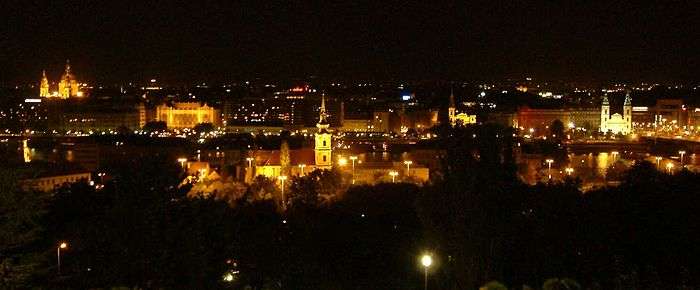Danube Promenade
Coordinates: 47°29′44″N 19°2′55″E / 47.49556°N 19.04861°E The Danube Promenade is located on the Pest side of Budapest, Hungary. On the bank of the Danube, this promenade extends from the Széchenyi Chain Bridge to the Erzsébet Bridge.

History
A row of hotels on the bank of the Danube began to be built in 1867: these were the Hungaria (1867 A. Skalinczky), Bristol, Carlton, and Ritz (Danube Palace). In 1945 at the end of World War II, only the Bristol (Danube Hotel) survived the destruction of the row of hotels on the bank of the Danube. In 1969 the final form of the Bristol Hotel was demolished.
Buildings and architecture
Buildings and landmarks in the promenade include:
- Belváros (Budapest)
- Contra-Aquincum (see also Pannonia or Hungarian: hu:Contra-Aquincum) - a 4th-century Roman castle near Erzsébet Bridge
- Gresham-palota near to Széchenyi Chain Bridge
- Hungarian Academy of Sciences near to Széchenyi Chain Bridge
- Vigadó Concert Hall
In the midst of boxes of glass hotels is the eccentric Neo-Byzantine Vigadó Concert Hall, which survived the building boom of the late 1960s. Behind the Vigadó is the local hub of the city, Vörösmarty tér, named after the 19th-century poet Mihály Vörösmarty. The traditional Gerbeaud coffeehouse has long been a great people watching spot. Váci utca and environs is the area for chic clothing, used books, folk art and sidewalk cafés. Further along the promenade is Március 15 tér, where the remains of a Roman bastion, Contra-Aquincum, were discovered, The Inner City Parish Church’s simple exterior conceals a colorful past: it began as a Romanesque basilica, was used as a mosque and was finally reconceived in the Baroque style in the 18th century.

Sculptures
- István Széchenyi - near to the Hungarian Academy of Sciences
- József Eötvös - 1879 sculptor Huszár Adolf
- Hungarian Seaman Memorial - the anchor of "Ungvár" (copy) - Szende Pál utca
- József Nádor Archduke Joseph, Palatine of Hungary
- Little Princess - near to Vigadó Concert Hall - Also in Marton László sculptors garden Naphegy Tigris utca, with other works.
- Attila József - famous poet of "At the Danube" also by László Marton (sculptor) at Hungarian Parliament Building
- Mihály Vörösmarty
- William Shakespeare
- Petőfi Sándor
- Shoes on the Danube Promenade Gyula Pauer and Can Togay - April 16. 2005.
Gallery
-

Little Princess
- old Danube Promenade
-

Danube Promenade about 1916.
-

Grand Hotel Hungária about 1910
-

from Vigado to Greek Church about 1890 - more photos: archive: [1]
-

old Danube Promenade, Petőfi Sándor tér
View from Danube Promenade

From left to right: Tabán Church; Buda Castle with the Royal Palace at night; Matthias Church; Széchenyi Chain Bridge
View to Danube Promenade from Naphegy

- Near Panoramic view from Naphegy at night - Photo taken from: Naphegy#Panoramic view points; From the left side: Saint Stephen's Basilica and Vigadó Concert Hall; In the front Tabán Church; On the right side Erzsébet Bridge
See also
Sources
- Budapest Info
- (100 years) Danube Promenade About 1900
- Danube Promenade About 1900
- Danube Promenade About 1937
- Contra Aquincum
External links
- Google search "Danube Promenade"
- Google search "Dunakorzó" (Hungarian name)
- Walking Tour 1: Pest's Inner City
Maps
- Google Map from Széchenyi Chain Bridge to Erzsébet Bridge
- Near view to Vigadó Tér and Vörösmarty tér on Google Map
- Danube Promenade on the old Map from 1905.
- 1905, the last years of Austria-Hungary.

